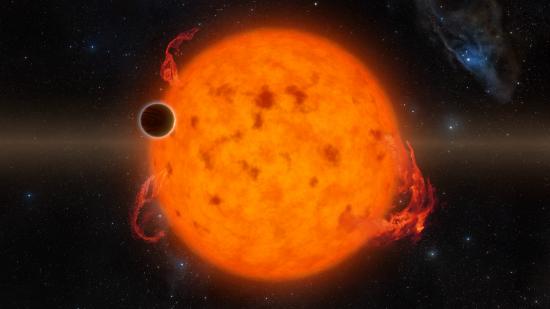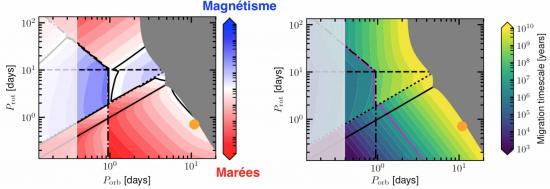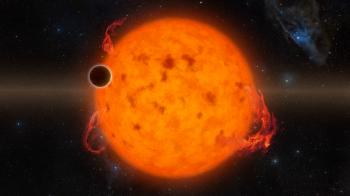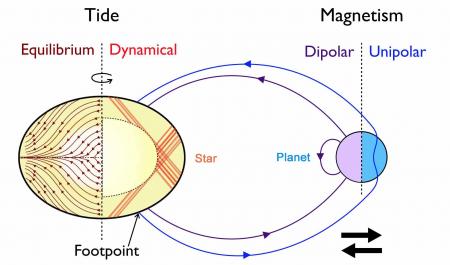A large part of the exoplanets known today are in very close orbit around their star, allowing very intense interactions between the planets and the host star. An international collaboration, led by researchers from Department of Astrophysics-AIM Laboratory at CEA-Irfu, has shown that these planets in close orbits migrate rapidly, due to the combined effect of tidal forces and magnetic forces. This study provides essential elements for understanding the formation and evolution of star-planet systems. These migration effects should soon be observable by missions like PLATO (PLAnetary Transits and Oscillations of Stars) of the European Space Agency (ESA) which will study the habitability zone of the planets. These results are published in the October 2017 issue of Astrophysical Journal Letters.
The migrating planets
Since their first discovery in 1995, more than 3,600 planets around stars other than the Sun have been detected. All these exo-planetary systems have a great diversity of planets, host stars and orbital distribution, which leads astrophysicists to consider exoplanetary environments very different from those we know in our solar system. Among these, many systems are said to be "compact" because one or more planet (s) are in very close orbit around their star. We do not know today whether these planets formed in the immediate vicinity of their star or whether they migrated or will migrate during the life of the system, moving away or moving closer during the evolution of the star .

The planet K2-33b, represented on this artist's view, is one of the youngest exoplanets detected to date. It is very close to its star and makes a complete orbit around it in about five days. Such planets are subject to interaction effects with their star that may cause them to migrate. Copyrights NASA / JPL-Caltech
The complex interaction of a planet with its host star
The migration of a planet in a close orbit can be caused by two complementary mechanisms. On the one hand, the magnetic forces are at the origin of an interaction between the magnetic field of the planet and the wind of magnetized matter coming from the star. On the other hand, the gravitational forces of tides, similar to those exerted by the Moon and the Sun on Earth, generate a large-scale flow (the equilibrium tide) due to the elongation of the body in the direction of the companion, as well as waves similar to the oceanic tides (dynamic tides). It is because of these tides that the Moon is moving away from the Earth little by little (about 3.8 cm / year). In the case of planetary systems, the dissipation of these waves generate deformations later or in advance with respect to the line connecting the planet to the center of the star. According to the relation between the spin period of the central star and the orbital period of the planet, a couple due to these tides applies then. It can be positive or negative and the planet can move closer to or away from the star.
Using scaling laws derived from fundamental principles of physics (both semi-analytical computations and ab initio numerical simulations), the researchers showed for the first time that both mechanisms could play a predominant role in planetary migration. Depending on the mass of the central star, the type of planet (giant gas or telluric), and the star spin period, one of the mechanisms can dominate the other. They also showed that both effects add up sometimes, making global migration more efficient than previously thought. Finally, they showed that, whatever the mechanism (tides or magnetism), the planet can either get closer to the star or move away from it, according to its position relative to the so-called "co-rotation" radius of the star : the distance at which a planet orbits around its star at the same rate than the star turns on itself.

Prediction of the interaction effects between a young star (TTauri type) and a Jupiter-type planet, depending on the orbital period of the planet (on the abscissa, equivalent of the orbital distance) and the spin period of the star (on the y-axis)
Left : the co-rotation, separating a migration that brings the planet closer to the star (on the left) or away from it (on the right), is given by the black oblique line. The red zones delimit the regions where the effects of tides dominate, and the areas in blue those where magnetism dominates. In the white areas, the two effects are of the same order of magnitude. Right : the prediction of the migration time of the planet is shown in color (logarithmic scale). The curve in purple indicates a migration time of 5 million years, which is a short time compared to the evolution of the star. Copyright DAp/CEA
All these results are particularly important to understand and explain the distance of exoplanets in close orbit around young stars (called "TTauri" type) because these stars have intense magnetic fields and change their spin period over times short compared to whole life of the star. They are also very important for predicting the distribution of planets around red dwarf stars (type M). For these stars, the habitable zone, i.e. the zone where liquid water may exist, is much closer than in the case of our Sun. For this reason, planets in close orbits around these stars are actively sought. This new description of planetary migration, which is much more complete than before, is therefore essential for future instruments and missions that will search and study exo-planets, such as TESS (Transiting Exoplanet Survey Satellite), SPIRou (Infrared Spectropolarimeter), PLATO (PLAnetary Transits and Oscillations of stars) ou encore le James Webb Space Telescope (JWST).
Contact : Antoine STRUGAREK
Publication :
“ The Fate of Close-in Planets: Tidal or Magnetic Migration? ”,
Strugarek A., Bolmont E., Mathis S., Brun A.S., Réville V., Gallet F., Charbonnel C.,
published in The Astrophysical Journal Letters, vol. 847, L16 (2017),
for an electronic version :  Strugarek_2017_ApJL_847_L16.pdf
Strugarek_2017_ApJL_847_L16.pdf
Content : A. Strugarek, J.M. Bonnet-Bidaud
• Structure and evolution of the Universe
• Institute of Research into the Fundamental Laws of the Universe • The Astrophysics Division (DAp)
• Laboratory Dynamics of Stars, (Exo)-planets and their Environment
• PLATO




